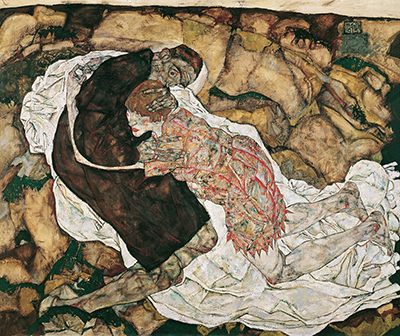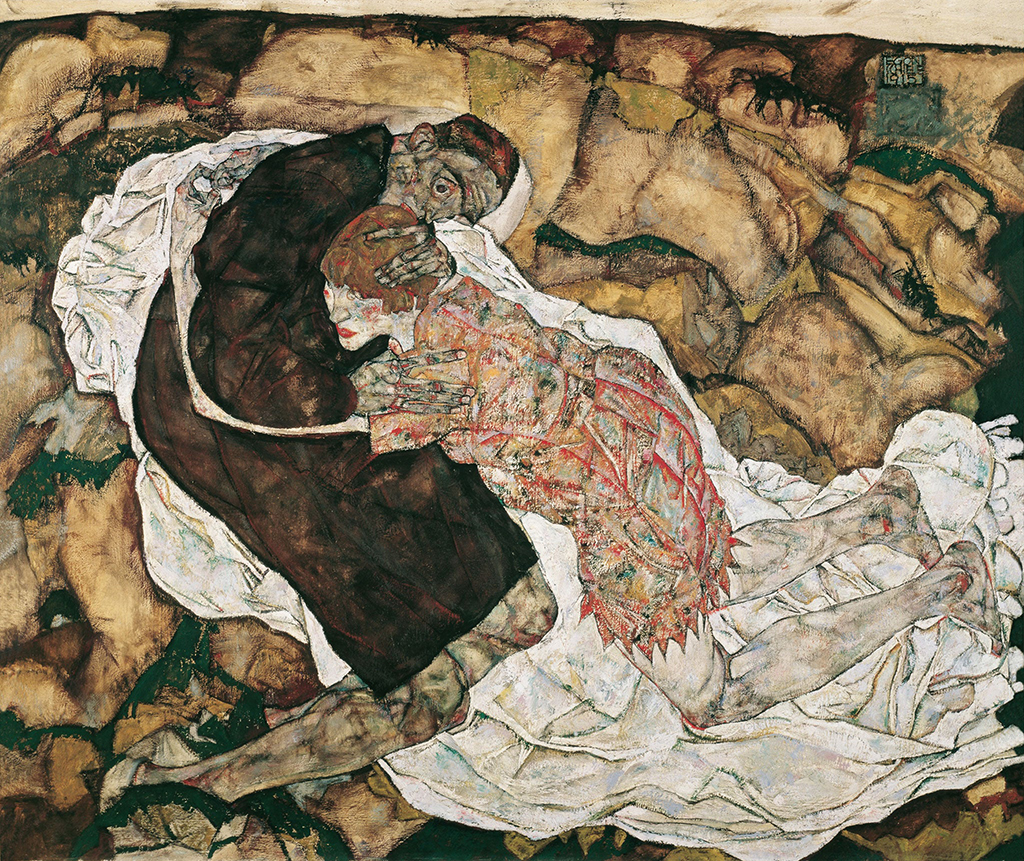Egon Schiele demonstrates here his skelton-like portraits with moody, expressive symbolism and intertwined bodies that remind us of his connection to his master, Gustav Klimt. Death and the Maiden touch on themes that held great significance within both artist's careers.
This expressive painting marks the mood of Schiele when he is on the verge of conscription for the First World War. The content found here suggests a certainty of death, if not in the war then at some point after. There is a sadness and loneliness to this and many other paintings from Schiele at around this time, but his work after getting married would become less manic and depressive. This route to relative positivity can be tracked down in many artist's careers, a new direction for Van Gogh, for example, being inspired by the colours of Southern France. There are stylistic and content elements here which link directly to the work of his mentor, Gustav Klimt.
That respected Austrian produced related titles such as Death and Life. The embrace found here does not symbolise comfort or security, or even the romance found with Klimt's The Kiss. Instead it represents more of an impending, unavoidable scenario of death. Schiele would delay his entry into WWI for as long as he could but eventually was unable to put it off anymore. When you consider the spread of Spanish Flu across the continent during at around this period, it truly was an awful time in European history. It is unsurprising, therefore, that Expressionist art would come out of this scenario, as artists attempted to make sense of these terrible times. The state of society has frequently impacted art in such a way, and war has left a particularly big impact on both. Schiele's work is probably today best known for two main genres, both his uplifting landscapes but also the expressive, contorted portraits as found here.
Looking at the composition itself, we find two desperate figures together in a sombre embrace. The figure nearest is a young woman dressed in a brightly patterned dress. She sports subtle makeup and a tidy hair style. Her dress is cut into pointed triangles at its bottom, finishing fairly high above the knee. Her feet are without any shoes and she leans over, balancing on her kneees. The other figure is a male dressed in dark brown in an unflattering outfit that bears no shape whatsoever. They embrace upon a bed sheet, as if in bed, though behind them is an outdoor setting of a unknown location. Their limbs are also elongated, though this is common throughout the artist's portraiture. Perhaps the setting is actually a hole dug for an impending death, just as was seen commonly throughout this period.
This artwork from 1915 can now be found at the Belvedere, Vienna, Austria, which hosts an exceptional collection within some of the finest Baroque architecture in Europe. They have a good breadth of styles covered, dating back to the early parts of the Renaissance, leading up to the mid-20th century. They also have a particular focus on Austrian artists, as you would imagine, and have a number of Klimt paintings here too. Aside from Schiele and Klimt, you may also be interested in the likes of Napoleon at the Great St Bernard by Jacques-Louis David, After the Bath by Pierre-Auguste Renoir, Lute player by Friedrich von Amerling and Triumphal procession through the Titus-arch by Vinzenz Fischer. All in all, this must be considered one of the finest art collections in Europe and also offers an excellent introduction to a large number of wide ranging artistic styles.





